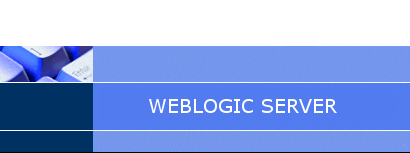What's New in Oracle WebLogic Server

New Features and Enhancements
- Dynamic clusters
Dynamic clusters consist of server instances that can be dynamically scaled up to meet the resource needs of your application. Dynamic clusters are based on a single shared server template. You use the server template to specify the configuration of the servers in your dynamic cluster so that each server does not need to be manually configured when expanding the cluster.
- Oracle Coherence integration
Coherence is integrated within WebLogic server as a container subsystem. The use of a container aligns the lifecycle of a Coherence member with the lifecycle of a Managed Server: starting or stopping a server JVM starts and stops a Coherence cluster member.
- WebSockets
WebLogic Server supports the WebSocket Protocol (RFC 6455), which provides
two-way, full-duplex communication over a single TCP connection.
- Maven archetypes
Consist of a Maven project and all the files necessary to support the project,
including code, HTML pages, resources, and more.
- OSGi bundles
Developers who want to use OSGi in their applications can easily share OSGi facilities
- Application Continuity support
A general purpose, application-independent infrastructure that enables recovery of work and masks many system, communication, and hardware failures.
- Advanced Queue messaging
Provides database-integrated message queuing. Leverages the functions of the Oracle database so that messages can be stored persistently, propagated between queues on different machines and databases, and transmitted using Oracle Net Services, HTTP(S), and SMTP
For more detailed information on new features and enhancements, see the What's New in Oracle WebLogic Server.
Support for Multiple Programming Models

WebLogic Server provides a full and 100% compatible implementation of the full Java Platform, Enterprise Edition (Java EE 6) specification.
- Java EE 6, including these APIs and features:
- JavaServer Faces (JSF) 2.1
- Servlet 3.0
- JavaServer Pages (JSP) 2.2
- Enterprise JavaBeans (EJB) 3.1
- Java Persistence API (JPA) 2.0
- Context and Dependency Injection (CDI) 1.0 new
- Bean Validation 1.0 new
- Java API for Restful Web Services (JAX-RS) 1.1 new
- Simpler and easier packaging model, with Web applications containing local EJB modules – WAR is the new EAR
- Spring
- Certified with Spring 3.0.x
- Spring Console Extension
- Exposure of JMS resources to Spring
- Injection of Transaction Manager and JMX MBeanServer references
See the What's New in Oracle WebLogic Server for more information.
|
Learn About WebLogic Server

Resources Available with your WebLogic Server Installation
- Administration Console
A Web browser-based, graphical user interface that you use to manage WebLogic Server. Use the username and password you entered when creating Weblogic samples domains
- Code Examples and Sample Applications
WebLogic Server provides a variety of code examples that show configuration and API use, including a set of Coherence examples. Code examples and sample
applications are not installed by default. You must perform a custom installation and select to install the Complete Installation.
- Fast Track Deployment and Administrator Guide
Learn how to quickly deploy Java Platform, Enterprise Edition (Java EE) applications and access system administration tools.
- Avitek Medical Records Sample Application
The Avitek Medical Records application is an educational tool for all levels of Java EE developers.
It showcases the use of each Java EE component, and illustrates best practice design patterns for component interaction and
client development. MedRec also illustrates best practices for developing and deploying applications with WebLogic Server.
Complete source code and documentation is available for this application.
To launch the Medical Records Application, first shut down the current
WebLogic Server instance using the Shut Down Server button
in the top right corner of this page. Then run
the startWebLogic
script from the MedRec domain root directory. By default, this is the ORACLE_HOME/user_projects/domains/medrec directory,
where ORACLE_HOME represents the directory you specified as the Oracle Home when you installed WebLogic Server; for example, C:\Oracle\Middleware\Oracle_Home.
- Avitek Medical Records Sample Application (Spring Version)
A Spring version of the Avitek Medical Records application is now available!
To launch the Spring version of the Medical Records Application, first shut down the current
WebLogic Server instance using the Shut Down Server button
in the top right corner of this page. Then run
the startWebLogic
script from the Medrec Spring domain root directory. By default, this is the ORACLE_HOME/user_projects/domains/medrec-spring directory.
Resources Available on the Internet
|


![]()